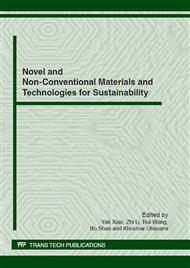p.710
p.717
p.724
p.730
p.737
p.745
p.749
p.755
p.763
Micro-Silica for High-End Application from Carbon Capture and Storage by Mineralisation
Abstract:
Waste silica remaining after the Carbon Capture and Storage by Mineral carbonation (CCSM) could represent a potential pozzolan material for partial replacement in concrete. The objective of this work was the production and testing of cement gel cubes with the residual-silica by-product obtained from the accelerated carbonation of Mg-silicate rocks. The silica produced was characterised in terms of its chemical composition, morphology and LOI. Also, the silica was used as an additive to the cement (CEM I class) in order to assess the effect on (28 days) compressive strength in comparison with a cement control specimen. The influence of different cement replacement percentages (5% and 10wt.% silica) were determined by measuring initial setting times and compressive strength. The compressive strength of the cement specimens with 5 and 10wt.% silica as pozzolan replacement of Portland cement were 3% and 8% higher than the control cubes indicating that the residual silica powder may have pozzolanic properties. However, high LOI and magnesium content might represent a limit in high-end applications and further work is required to identify optimised CCSM conditions able to reduce the impurities in the silica by-product and to establish their potential as a pozzolan.
Info:
Periodical:
Pages:
737-744
Citation:
Online since:
June 2012
Keywords:
Price:
Сopyright:
© 2012 Trans Tech Publications Ltd. All Rights Reserved
Share:
Citation:


